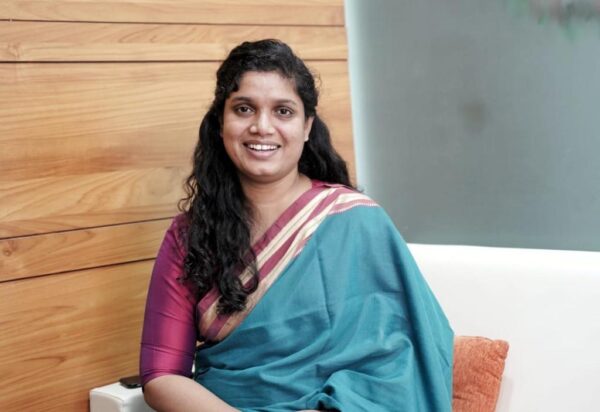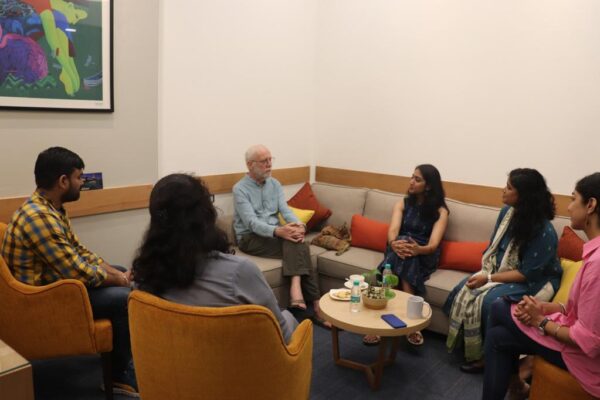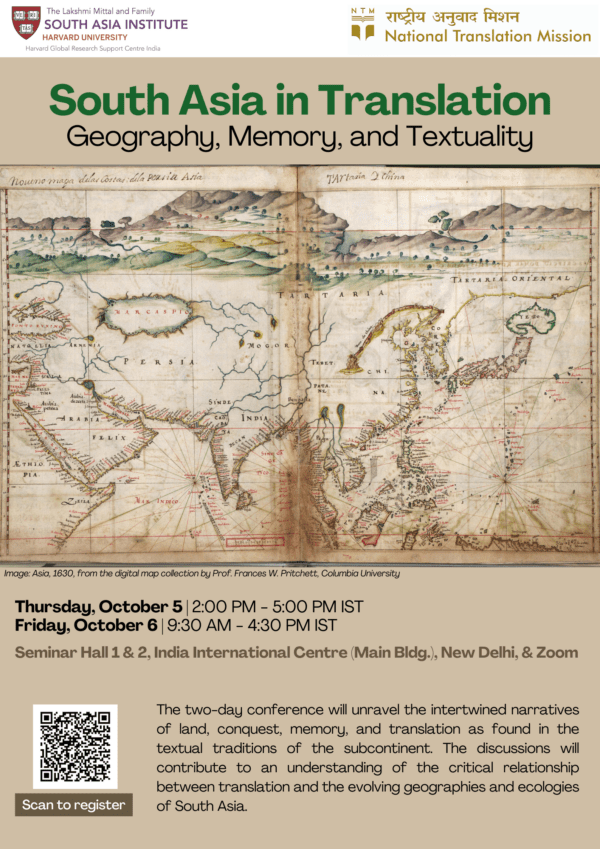
From left to right: 1929 edition of Stotramala; Asiatic Society Library, Mumbai; 1841 edition of Yatrik Kraman
On October 5 and 6, the Mittal Institute will host the “South Asia in Translation: Geography, Memory, and Textuality” conference, in collaboration with the National Translation Mission, CIIL, Mysore, Ministry of Education, Govt of India, which will trace intersecting themes of translation, geography, memory and place within the framework of the geographical settings in which knowledge and power were transacted. It will attempt to unravel the intertwined narratives of land, conquest, memory, and translation as found in the textual traditions of the subcontinent. This conference will also contribute to an understanding of translation as a key tool in studying the evolving geographies and ecologies of South Asia. The conference will begin with a keynote lecture on “Translation as Desire” by Arvind Krishna Mehrotra, eminent poet, critic, and translator. The keynote will be followed by a plenary session on “Worlds of Translation: Reflections on Some Larger Projects of ‘Translation’ in the South Asian Context” by Francis X. Clooney, Parker Professor of Divinity, Harvard University. Since in-person registration is full, attendees can register to attend via Zoom.
We spoke with conference convener Annie Rachel Royson, Mittal Institute India Fellow based in our Delhi office. Annie works under the mentorship of Vidyan Ravinthiran, Gardner Cowles Associate Professor of the Humanities at Harvard University, who will chair the conference. Annie shared the motivations behind the conference, and what she hopes attendees can glean from the panel discussions.

Annie at Mittal Institute, Delhi Office
Mittal Institute: Annie, thank you for speaking with us about this conference, which is a culmination of your research on translation at the Mittal Institute. Could you elaborate on the various literary, social, and cultural dimensions of your field, and how these intersect in the conference theme? Can you tell us briefly about the relationship between translation, geography, and memory?
Annie Rachel Royson: My research, and more specifically my current project at the Mittal Institute, focuses on South Asian literary texts and translations, sacred texts, and their landscapes. The study explores two Marathi works of translation/retelling from the nineteenth century, Yātrik Kramaṇ (1841) and Khristāyan (1919). The nineteenth century is notable for a large volume of translations between South Asian and European languages. The translations of this period informed the European imagination about the subcontinent, and in turn, led to transformations in the cultural and geographical terrain of South Asia. There is a deep connection between geography, land, and the identity of communities that call these places their own. The attempt is to investigate how literary texts and translations lead us to a better understanding of the relationship between landscape and memory; of how translated works can provide “new landscapes” which in turn also contribute to the geographical evolution of the region. To put it simply, the attempt through the conference is to explore all aspects of translation, geography, and memory, with South Asian spaces/places as the focal lens.
Mittal Institute: How did your work as an LMSAI fellow lead you to coordinate this conference?
Annie Rachel Royson: My work as an India Fellow at LMSAI gave me the scope to explore all aspects of my primary texts and use resources from Harvard library and other places to strengthen my research. My own work deals with the translation of sacred texts, but the idea was that South Asia is a very rich region as far as textual translation is concerned and there are other texts that could be studied to understand the critical relationship between translation, geography, and memory. My faculty mentor at Harvard, Prof. Vidyan Ravinthiran, and I conceptualized this conference as an attempt to bring together scholars who could theorize on this theme from the varied perspectives that the region of South Asia offers. The attempt in the conference will be to build a vocabulary around translation and geography in the South Asian context or study the geography and ecology of South Asia through its translations. There has been immense support from the Mittal Institute team from the conceptualization stage to working out all other details of the conference. It is also a matter of delight that we are organizing this conference in collaboration with the National Translation Mission at the Central Institute of Indian Languages. Our hope is that the combined expertise and scholarship at both institutes will come together to create meaningful conversations during this two-day conference.
Mittal Institute: Could you elaborate on some of the panels in the conference and how they tie in with the overall theme?
Annie Rachel Royson: The conference will be in a hybrid format with speakers and attendees in Delhi as well as online. We are bringing together senior scholars and younger researchers from the field. The panels are thematically arranged and will look at space/place, memory, and translation through various lenses: poetry, sacred-text traditions, displacement and trauma, cartography, cityscapes, among other approaches. We will also have conversations around translation and memory in the digital age. The panels will explore how literary places are transformed when translation moves a text from its “home” to a new space/place and analyse landscape writing in translated texts. We also hope that there will be some discussion on how translations – sacred, literary, and administrative – influenced how the geographical landscape of South Asian regions evolved.

Meeting with Francis X. Clooney, Parkman Professor of Divinity, Harvard University
Mittal Institute: You recently authored a book, titled Texts, Traditions, and Sacredness: Cultural Translation in Kristapurāṇa. Could you elaborate on your process as a researcher and writer?
Annie Rachel Royson: Yes. My book Texts, Traditions, and Sacredness: Cultural Translation in Kristapurāṇa came out in January 2023. It is an outcome of my doctoral research on Kristapurāṇa (1616). For me, it is a result of a long-standing fascination with the text as well as with sacred-text translation in general. With a poetic text as complex as Kristapurāṇa, the only way to write anything meaningful, in my opinion, is to immerse yourself in the text as much as possible, and surrender to it, while also looking critically at other texts and contexts that shaped the work. It is a balancing act, and I went through all the throes of reading writing, revising, which all academic writers go through, with a lot of help from mentors, colleagues, editors, and many others. The book presents a critical reading of Kristapurāṇa, the first South Asian retelling of the Bible. Kristapurāṇa is a sweeping narrative with 10,962 verses, an epic poetic retelling of the Christian Bible in the Marathi language. My book contributes to an understanding of translation as it was practiced in South Asia through its study of genre, landscapes, and cultural translation in Kristapurāṇa, while also retelling a history of sacred texts and biblical narratives in the region. It examines themes such as the complexities of the colonial machinery, religious encounters, textual traditions, and multilingualism, providing insight into Portuguese Goa of the sixteenth and seventeenth centuries.
Mittal Institute: What are your research goals following this conference? Will you continue to expand on the conversations at the conference?
Annie Rachel Royson: Yes. In the last few months at the Institute, I have been able to successfully get this new research project underway and conduct some archival research. I hope to continue to explore this area of research. We are also planning to bring together the conference papers in an edited volume and invite other scholars to contribute to the discussion. Both of my primary texts for this project are complex works and a lot remains to be studied, and there are unexplored aspects that I hope will emerge during and after the conference.

